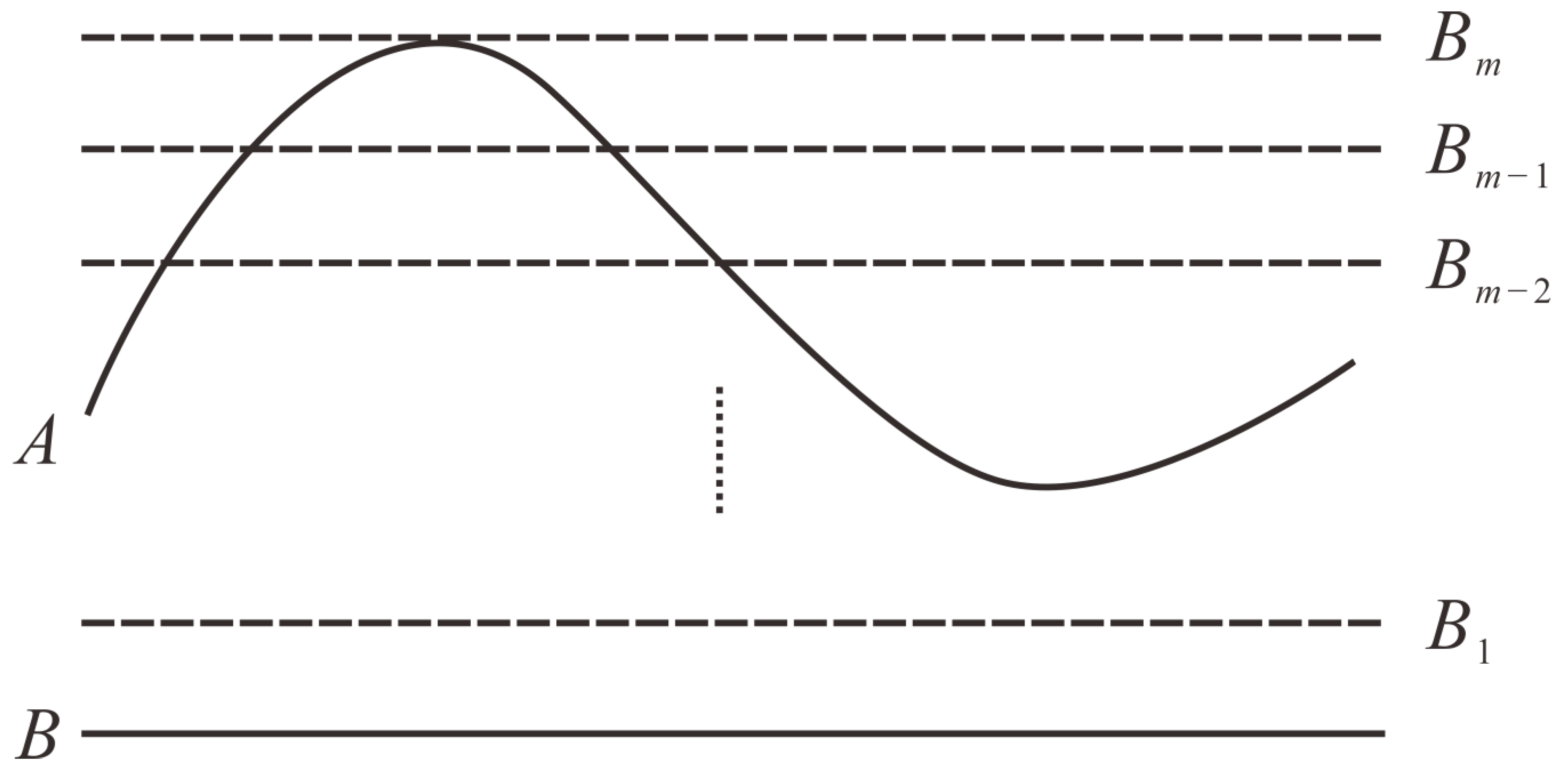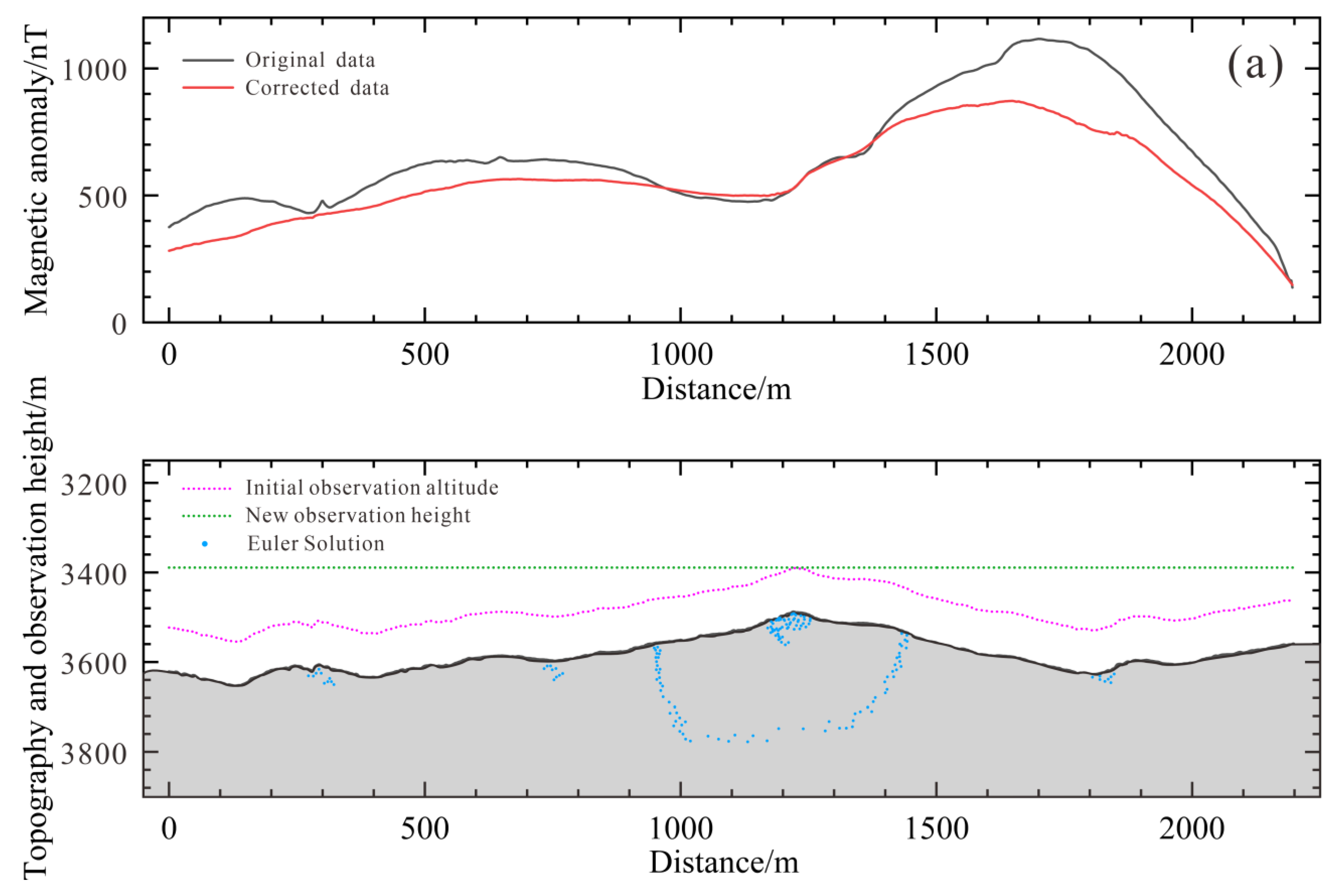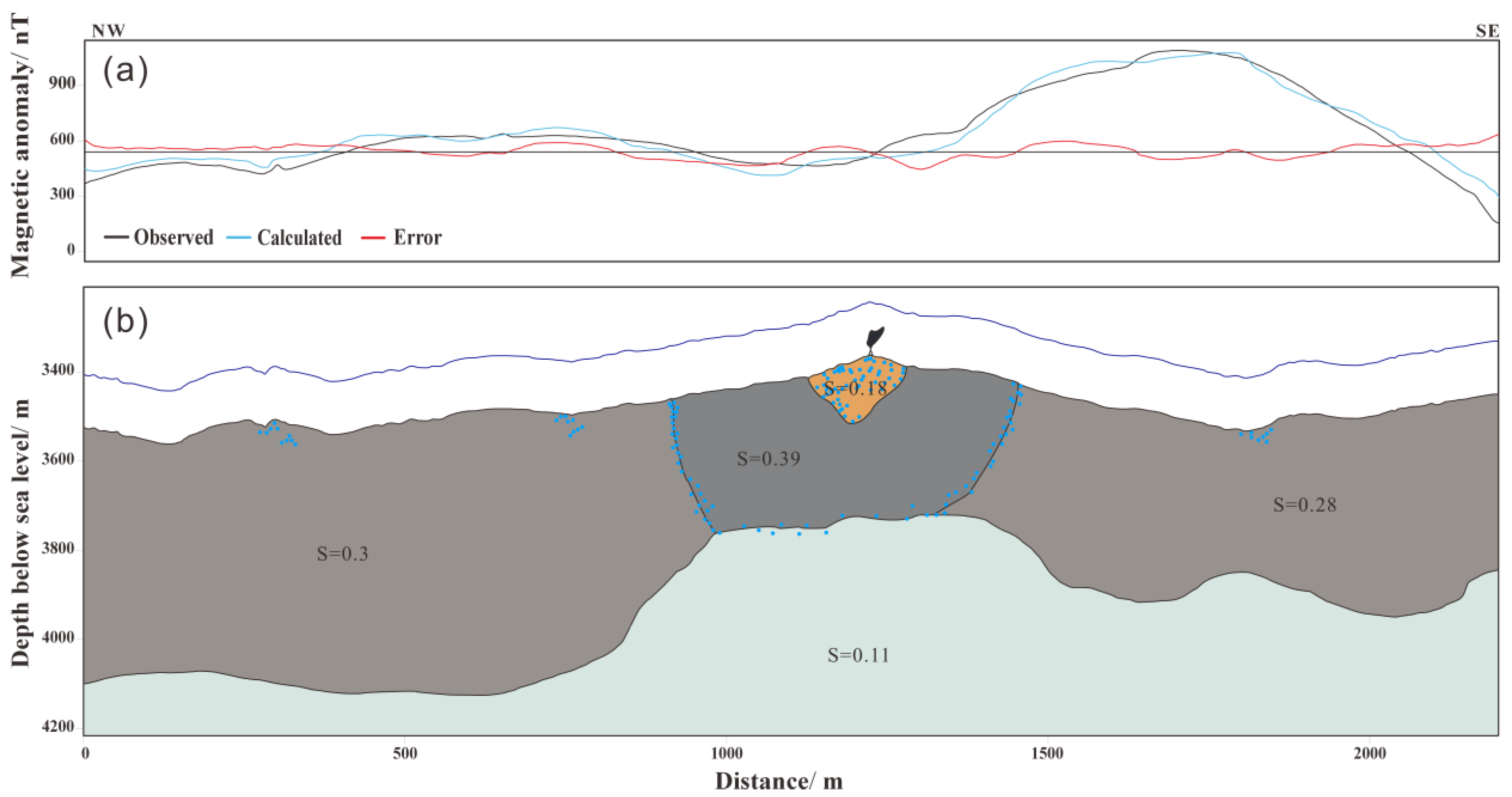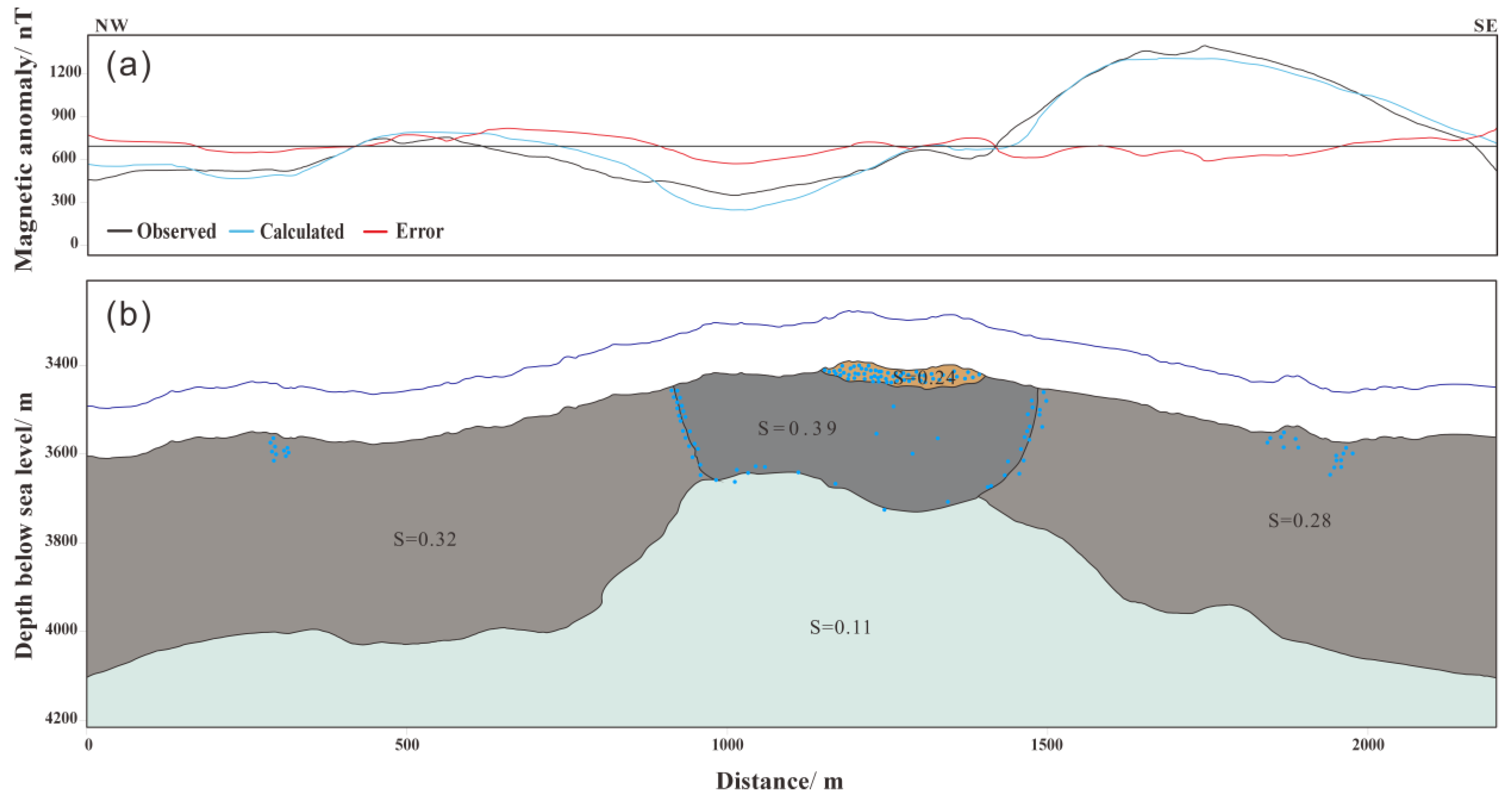The Structure and Near-Bottom Magnetic Anomaly Characteristics of the Daxi Vent Field on the Carlsberg Ridge, Northwestern Indian Ocean
Abstract
1. Introduction
2. Geological Setting
3. Data and Methods
3.1. Data Acquisition and Process
3.2. Methods
3.2.1. Magnetic Anomaly Leveling
- Dividing the space between the top horizontal surface (Bm) and the lower horizontal surface (B) of the undulating observation surface (A) into several equal-spaced sub-surfaces (Bi), as Figure 3 shows;
- the magnetic potential field values of the undulating observation surface (A) are projected onto the bottom horizontal surface (B) and used as the initial potential field values of that surface;
- the potential field values of each sub-horizontal surface (Bi) are calculated using frequency-domain upward continuation. These values are interpolated to approximate the potential field of the undulating observation surface (A);
- the residuals between the observed and approximated magnetic anomaly values of the undulating observation surface (A) are calculated and used to correct the magnetic anomaly values on the bottom horizontal surface (B). This process is repeated iteratively until the residuals between the observed and approximated potential field values of the undulating observation surface (A) fall within an acceptable error tolerance.
3.2.2. Euler Deconvolution
3.2.3. Magnetic Forward Modeling
4. Results and Discussion
4.1. The aa′ Profile Cross the Central Mound
4.2. The bb′ Profile Cross the NE Mound
4.3. Structure of the Hydrothermal Field
5. Conclusions
Author Contributions
Funding
Institutional Review Board Statement
Informed Consent Statement
Data Availability Statement
Conflicts of Interest
References
- Rona, P.A. Resources of the Sea Floor. Science 2003, 299, 673–674. [Google Scholar] [CrossRef]
- Cathles, L.M. What processes at mid-ocean ridges tell us about volcanogenic massive sulfide deposits. Min. Depos. 2011, 46, 639–657. [Google Scholar] [CrossRef]
- Rona, P.A. Criteria for recognition of hydrothermal mineral deposits in oceanic crust. Econ. Geol. 1978, 73, 135–160. [Google Scholar] [CrossRef]
- Kent, D.V.; Gee, J. Magnetic alteration of zero-age oceanic basalt. Geology 1996, 24, 703–706. [Google Scholar] [CrossRef]
- de Ronde, C.E.J.; Hannington, M.D.; Stoffers, P.; Wright, I.C.; Ditchburn, R.G.; Reyes, A.G.; Baker, E.T.; Massoth, G.J.; Lupton, J.E.; Walker, S.L.; et al. Evolution of a Submarine Magmatic-Hydrothermal System: Brothers Volcano, Southern Kermadec Arc, New Zealand. Soc. Econ. Geol. 2005, 100, 1097–1133. [Google Scholar] [CrossRef]
- Szitkar, F.; Dyment, J.; Choi, Y.; Fouquet, Y. What causes low magnetization at basalt-hosted hydrothermal sites? Insights from inactive site Krasnov (MAR 16°38′ N). Geochem. Geophys. Geosyst. 2014, 15, 1441–1451. [Google Scholar] [CrossRef]
- Dyment, J.; Tamaki, K.; Horen, H.; Fouquet, Y.; Nakase, K.; Yamamoto, M.; Ravilly, M.; Kitazawa, M. A Positive Magnetic Anomaly at Rainbow Hydrothermal Site in Ultramafic Environment. Am. Geophys. Union 2005, 2005, OS21C-08. [Google Scholar]
- Charlou, J.L.; Donval, J.P.; Konn, C.; Ondréas, H.; Fouquet, Y.; Jean-Baptiste, P.; Fourré, E. High production and fluxes of H2 and CH4 and evidence of abiotic hydrocarbon synthesis by serpentinization in ultramafic-hosted hydrothermal systems on the Mid-Atlantic Ridge. Geophys. Monogr. Ser. 2010, 188, 265–296. [Google Scholar]
- Wu, T.; Tao, C.; Liu, C.; Li, H.; Wu, Z.; Wang, S.; Chen, Q. Geomagnetic Models and Edge Recognition of Hydrothermal Sulfide Deposits at Mid-ocean Ridges. Mar. Georesour. Geotecnol. 2015, 34, 630–637. [Google Scholar] [CrossRef]
- Tontini, F.C.; Davy, B.; De Ronde, C.E.J.; Embley, R.W.; Leybourne, M.; Tivey, M.A. Crustal magnetization of Brothers Volcano, New Zealand, measured by autonomous underwater vehicles; geophysical expression of a submarine hydrothermal system. Econ. Geol. Bull. Soc. Econ. Geol. 2012, 107, 1571–1581. [Google Scholar] [CrossRef]
- Tontini, F.C.; Crone, T.J.; de Ronde, C.E.J.; Fornari, D.J.; Kinsey, J.C.; Mittelstaedt, E.; Tivey, M. Crustal magnetization and the subseafloor structure of the ASHES vent field, Axial Seamount, Juan de Fuca Ridge; implications for the investigation of hydrothermal sites. Geophys. Res. Lett. 2016, 43, 6205–6211. [Google Scholar] [CrossRef]
- Cocchi, L.; Tontini, F.C.; Muccini, F.; de Ronde, C.E.J. Magnetic Expression of Hydrothermal Systems Hosted by Submarine Calderas in Subduction Settings: Examples from the Palinuro and Brothers Volcanoes. Geosciences 2021, 11, 504. [Google Scholar] [CrossRef]
- Szitkar, F.; Dyment, J.; Fouquet, Y.; Choi, Y.; Honsho, C. Absolute magnetization of the seafloor at a basalt-hosted hydrothermal site: Insights from a deep-sea submersible survey. Geophys. Res. Lett. 2015, 42, 1046–1052. [Google Scholar] [CrossRef]
- Tivey, M.A.; Rona, P.A.; Schouten, H. Reduced crustal magnetization beneath the active sulfide mound, TAG hydrothermal field, Mid-Atlantic Ridge at 26° N. Earth Planet. Sci. Lett. 1993, 115, 101–115. [Google Scholar] [CrossRef]
- Talwani, M.; Heirtzler, J.R. Computation of magnetic anomalies caused by two dimensional structures of arbitary shape. Comput. Miner. Ind. 1964, 1, 464–480. [Google Scholar]
- Rasmussen, R.; Pedersen, L.B. End corrections in potential field modeling. Geophys. Prospect. 1979, 27, 749–760. [Google Scholar] [CrossRef]
- Raju, K.K.; Chaubey, A.; Amarnath, D.; Mudholkar, A. Morphotectonics of the Carlsberg Ridge between 62°20′ and 66°20′ E, northwest Indian Ocean. Mar. Geol. 2008, 252, 120–128. [Google Scholar] [CrossRef]
- Han, X.; Wu, Z.; Qiu, B. Morphotectonic characteristics of the northern part of the Carlsberg Ridge near the Owen Fracture Zone and the occurrence of oceanic core complex formation. AGU Fall Meet. Abstr. 2012, 2012, OS13B-1722. [Google Scholar]
- Jiang, Z.; Han, X.; Wang, Y.; Qiu, Z. Characteristics of water chemistry and constituents of particles in the hydrothermal plume near 6°48′ N, Carlsberg Ridge, Northwest Indian Ocean. J. Mar. Sci. 2017, 35, 34–43. [Google Scholar] [CrossRef]
- Wang, Y.; Han, X.; Zhou, Y.; Qiu, Z.; Yu, X.; Petersen, S.; Li, H.; Yang, M.; Chen, Y.; Liu, J.; et al. The Daxi Vent Field: An active mafic-hosted hydrothermal system at a non-transform offset on the slow-spreading Carlsberg Ridge, 6°48′ N. Ore Geol. Rev. 2021, 129, 103888. [Google Scholar] [CrossRef]
- Jamieson, J.W.; Clague, D.A.; Hannington, M.D. Hydrothermal sulfide accumulation along the Endeavour Segment, Juan de Fuca Ridge. Earth Planet. Sci. Lett. 2014, 395, 136–148. [Google Scholar] [CrossRef]
- Honsho, C.; Ura, T.; Kim, K. Deep-sea magnetic vector anomalies over the Hakurei hydrothermal field and the Bayonnaise knoll caldera, Izu-Ogasawara arc, Japan. J. Geophys. Res. Solid Earth 2013, 118, 5147–5164. [Google Scholar] [CrossRef]
- Bloomer, S.; Kowalczyk, P.; Williams, J.; Wass, T.; Enmoto, K. Compensation of magnetic data for autonomous underwater vehicle mapping surveys. In Proceedings of the 2014 IEEE/OES Autonomous Underwater Vehicles (AUV), Oxford, MS, USA, 6–9 October 2014. [Google Scholar]
- Xu, S.; Yu, H. The Interpolation-Iteration Method for Potential Field Continuation from Undulating Surface to Plane. Chin. J. Geophys. 2007, 50, 1566–1570. [Google Scholar] [CrossRef]
- Reid, A.B.; Allsop, J.M.; Granser, H.; Millett, A.J.; Somerton, I.W. Magnetic interpretation in three dimensions using Euler deconvolution. Geophysics 1990, 55, 80–91. [Google Scholar] [CrossRef]
- Reid, A.B.; Ebbing, J.; Webb, S.J. Avoidable Euler Errors—The use and abuse of Euler deconvolution applied to potential fields. Geophys. Prospect. 2014, 62, 1162–1168. [Google Scholar] [CrossRef]
- Lim, A.; Brönner, M.; Johansen, S.E.; Dumais, M. Hydrothermal Activity at the Ultraslow-Spreading Mohns Ridge: New Insights From Near-Seafloor Magnetics. Geochem. Geophys. Geosyst. 2019, 20, 5691–5709. [Google Scholar] [CrossRef]
- Tontini, F.C.; de Ronde, C.E.J.; Kinsey, J.C.; Soule, A.; Yoerger, D.; Cocchi, L. Geophysical modeling of collapse-prone zones at Rumble III seamount, southern Pacific Ocean, New Zealand. Geochem. Geophys. Geosyst. 2013, 14, 4667–4680. [Google Scholar] [CrossRef]
- Bronner, A.; Sauter, D.; Munschy, M.; Carlut, J.; Searle, R.; Cannat, M.; Manatschal, G. Magnetic signature of large exhumed mantle domains of the Southwest Indian Ridge—Results from a deep-tow geophysical survey over 0 to 11 Ma old seafloor. Solid Earth 2014, 5, 339–354. [Google Scholar] [CrossRef]
- Johnson, H.P.; Tivey, M.A. Magnetic properties of zero-age oceanic crust; a new submarine lava flow on the Juan de Fuca Ridge. Geophys. Res. Lett. 1995, 22, 175–178. [Google Scholar] [CrossRef]
- Cherkashov, G.; Poroshina, I.; Stepanova, T.; Ivanov, V.; Bel’Tenev, V.; Lazareva, L.; Rozhdestvenskaya, I.; Samovarov, M.; Shilov, V.; Glasby, G.P.; et al. Seafloor massive sulfides from the northern equatorial Mid-Atlantic Ridge; new discoveries and perspectives. Mar. Georesour. Geotechnol. 2010, 28, 222–239. [Google Scholar] [CrossRef]
- Wu, X.; Han, X.; Wang, Y.; Garbe-Schönberg, D.; Schmidt, M.; Zhang, Z.; Qiu, Z.; Zong, T.; Zhou, P.; Yu, X.; et al. Geochemistry of vent fluids from the Daxi Vent Field, Carlsberg Ridge, Indian Ocean: Constraints on subseafloor processes beneath a non-transform offset. Mar. Geol. 2023, 455, 106955. [Google Scholar] [CrossRef]
- Canales, J.P.; Dunn, R.A.; Arai, R.; Sohn, R.A. Seismic imaging of magma sills beneath an ultramafic-hosted hydrothermal system. Geology 2017, 45, 451–454. [Google Scholar] [CrossRef]
- Melchert, B.; Devey, C.; German, C.; Lackschewitz, K.; Seifert, R.; Walter, M.; Mertens, C.; Yoerger, D.; Baker, E.; Paulick, H.; et al. First evidence for high-temperature off-axis venting of deep crustal/mantle heat: The Nibelungen hydrothermal field, southern Mid-Atlantic Ridge. Earth Planet. Sci. Lett. 2008, 275, 61–69. [Google Scholar] [CrossRef]
- Tivey, M.A.; Dyment, J. The magnetic signature of hydrothermal systems in slow spreading environments. In Diversity of Hydrothermal Systems on Slow Spreading Ocean Ridges; Rona, P.A., Devey, C.W., Dyment, J., Murton, B.J., Eds.; American Geophysical Union: Washington, DC, USA, 2010; Volume 188, pp. 43–66. [Google Scholar] [CrossRef]









Disclaimer/Publisher’s Note: The statements, opinions and data contained in all publications are solely those of the individual author(s) and contributor(s) and not of MDPI and/or the editor(s). MDPI and/or the editor(s) disclaim responsibility for any injury to people or property resulting from any ideas, methods, instructions or products referred to in the content. |
© 2025 by the authors. Licensee MDPI, Basel, Switzerland. This article is an open access article distributed under the terms and conditions of the Creative Commons Attribution (CC BY) license (https://creativecommons.org/licenses/by/4.0/).
Share and Cite
Zhao, P.; Wu, Z.; Han, X.; Wang, Y.; Zhang, J.; Wang, Q. The Structure and Near-Bottom Magnetic Anomaly Characteristics of the Daxi Vent Field on the Carlsberg Ridge, Northwestern Indian Ocean. J. Mar. Sci. Eng. 2025, 13, 488. https://doi.org/10.3390/jmse13030488
Zhao P, Wu Z, Han X, Wang Y, Zhang J, Wang Q. The Structure and Near-Bottom Magnetic Anomaly Characteristics of the Daxi Vent Field on the Carlsberg Ridge, Northwestern Indian Ocean. Journal of Marine Science and Engineering. 2025; 13(3):488. https://doi.org/10.3390/jmse13030488
Chicago/Turabian StyleZhao, Puchen, Zhaocai Wu, Xiqiu Han, Yejian Wang, Jialing Zhang, and Qiang Wang. 2025. "The Structure and Near-Bottom Magnetic Anomaly Characteristics of the Daxi Vent Field on the Carlsberg Ridge, Northwestern Indian Ocean" Journal of Marine Science and Engineering 13, no. 3: 488. https://doi.org/10.3390/jmse13030488
APA StyleZhao, P., Wu, Z., Han, X., Wang, Y., Zhang, J., & Wang, Q. (2025). The Structure and Near-Bottom Magnetic Anomaly Characteristics of the Daxi Vent Field on the Carlsberg Ridge, Northwestern Indian Ocean. Journal of Marine Science and Engineering, 13(3), 488. https://doi.org/10.3390/jmse13030488





